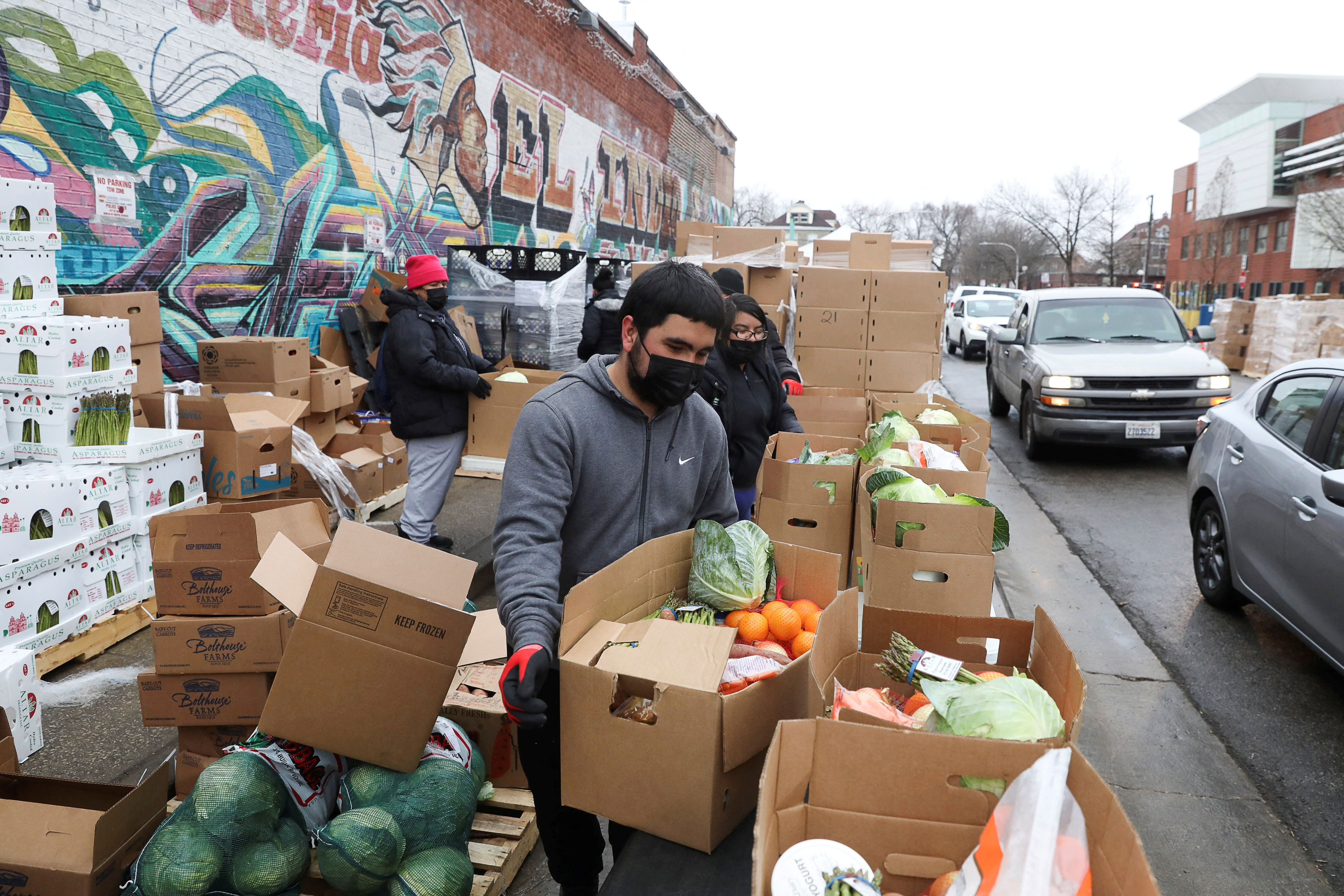风萧萧_Frank
以文会友Return to Pandemic Hunger Levels Could Signal Economic Fragility
U.S. food banks warn of strain as Republicans seek food aid cuts
回到大流行时期的饥饿水平可能预示着美国经济的脆弱性
当经济学家和投资者搜寻有关通胀、就业、住房、银行和其他风向性指标的数据,以确定美国是否正走向衰退时,参观美国最大的食品银行仓库,可以提供一些不祥的线索。
这家非营利组织的高管表示,亚特兰大社区食品银行一半以上的货架都是空的,部分原因是供应链问题,但主要是因为对食品援助的需求与COVID-19大流行期间一样高。他们说,今年在亚特兰大地区,五分之二的寻求食品援助的人以前没有这样做过。
“没有人预料到这一点,”这家私人慈善机构的首席财务官Debra Shoaf说。该机构依靠企业和个人捐款以及政府拨款,向乔治亚州29个县的饥饿人口分发食物。Shoaf同时也是全国慈善机构“喂养美国”的财务指导委员会成员,她说她在美国各地都听到了类似的报告。“我们又回到了大流行时期的水平,”她说。
在一些地区,需求甚至超过了COVID大流行最严重的日子。在俄亥俄州中部,当地食品银行表示,自去年以来,寻求援助的家庭数量增加了近一半。
美国人口普查局(Census Bureau)的数据显示,4月初有超过1,140万户家庭领取了免费食品杂货,较上年同期增长了15%。
“食品银行已经存在了50年,但这是我们第一次看到前所未有的高食品需求和历史上最低的失业率,”Vince Hall说,他是“喂养美国”的首席政府关系官,该组织支持6万个食品储藏室。
随着大多数政府流行病紧急援助的结束,持续的需求出现了,特别是与covid有关的补充营养援助计划(SNAP)的临时增加,该计划以前称为食品券,是一项联邦计划,提供借记卡直接在商店购买食品。
通货膨胀也是一个主要因素:根据美国劳工统计局的数据,自2020年3月疫情开始以来,食品价格上涨了23%。
东北大学(Northeastern University)商学教授John Lowrey的研究重点是食品银行管理和公共卫生,他说,Covid后对免费食品的需求对经济来说“不是一个好信号”,“也许是即将到来的衰退的一个指标”。
Lowrey说:“事实上,我们有很多第一次使用食品的人不再担心去食品储藏室的耻辱,而是看到了它的价值,因为他们再也买不起零售食品了。这是经济和消费者健康状况的合理代表。”
贝勒大学(Baylor University)经济学教授Craig Gundersen是“供养美国”(Feeding America)的知名研究员,他说,食物银行出现高于COVID水平的峰值是异常情况。他说,看到今年的需求增加并不奇怪,因为政府在大流行的紧急情况下提供了如此多的援助。他还指出,SNAP福利在2021年的强制审查后向上调整了,现在仍然比四年前高。
Gundersen说:“我们有经济刺激计划,很长一段时间人们不用付房租,失业救济金也高于工资。”
Blue Ridge Area Food Bank的首席执行官Michael McKee表示,COVID紧急援助掩盖了潜在的经济现实。该银行为弗吉尼亚州阿巴Labor小道上的25个县提供服务。根据美国劳工统计局(Bureau of Labor Statistics)的最新数据,自2020年3月以来,通货膨胀率超过了工资涨幅。
McKee说:“现在发生的事情揭示了这个国家粮食不安全的范围、规模和普遍性,以及不平等的影响。不平等最近不仅来自通货膨胀,还来自工资无法跟上生活成本的增长。”
“未知的领域”
一个复杂的因素是:政府食品援助问题已经卷入了议员们关于是否提高国家债务上限的辩论。
国会共和党人提议限制粮食援助,作为打击美国众议院议长麦卡锡所说的拜登总统“不计后果的支出”的一揽子措施的一部分。
拜登总统抨击了共和党的提案,认为这会伤害低收入美国人。反饥饿倡导者告诉路透社,使人们更难获得SNAP的政策可能会给食品银行和其他紧急食品供应商带来进一步的压力。
SNAP政府项目是迄今为止美国为饥饿人口提供食物的最大方法。食品银行和食品储藏室的餐食分发量约为前者的十分之一,但它们仍然是第二大供应者,因此是社会安全网的重要组成部分。
随着新冠疫情时期对SNAP的临时补充停止,从乔治亚州到科罗拉多州再到弗吉尼亚州的食品银行表示,对他们服务的需求有所增长。
在20个县开展业务的俄亥俄州中部食品协会(Mid-Ohio Food Collective)报告称,今年前三个月,家庭食品储藏室的访问量比去年同期增加了约45%,从约27万次增加到约39万次。
“我们正处于未知的领域,”该慈善机构的发言人Mike Hochron说。“家庭预算紧张,比以往任何时候都有更多的人求助于紧急系统来避免饥饿。”
自1988年以来一直在该行业工作的休斯顿食品银行首席执行长Brian Greene说,很难进行长期比较,因为需求历来超过供应。他说,休斯顿食品银行是全国最大的食品银行,今年分发的食品比去年少,但这是因为现金和食品捐赠减少了。
他说:“如果我们有疫情期间那么多的食物,我们就会分发出去。”
弗吉尼亚州蓝岭食品银行(Blue Ridge food bank)提供的食品储藏室也报告了最近的价格飙升。2021年4月,杜勒斯南食品储藏室每周为109个家庭提供服务。去年4月,它帮助了147个。这个月,这个数字是每周183个家庭。
弗吉尼亚州温彻斯特的高地食品储藏室表示,在疫情期间,它每周为大约90个家庭提供服务。这个月,它为大约135个家庭提供了服务。新客户中包括47岁的杂工海伍德-纽曼(Haywood Newman),他在没有援助的情况下度过了COVID,但他说他现在正在挣扎。
“你得付水费、垃圾费、电费、车费和房租——这些公司是不会帮你的,”纽曼说。
微薄的利润
在亚特兰大,全国最大的食品银行仓库占地4英亩。供应主管Michelle Grear说,它的设计目的是储存大约500万磅的食品,其中大部分是食品制造商和杂货店用托盘捐赠的。她说,上个月的平均库存仅为180万磅。
到货的食品很快就被抢购一空,在许多情况下,街边的食品储藏室在几个小时内就被认领了。据Grear说,今年3月,仓库收到了980万英镑,分发了960万英镑,利润微薄。
31岁的单身母亲莎朗·怀特(Sharawn White)在一家房地产公司工作,时薪约为18美元。本月,她第一次来到亚特兰大地区的食品储藏室。怀特说,在支付了日托费、房租和水电费后,她每个月还有大约300美元用于食物、汽油和意外开支。
四月初,怀特参观了一个社区中心捐赠旧衣服,并注意到食品储藏室正在排队。她说:“这最终成为一件巨大的幸事。”
像大多数地区食品银行一样,亚特兰大的这家食品银行依靠政府资助的项目和企业和制造商的产品捐赠来获得食品——他们尽量不自己花钱购买食品,除非遇到危机。根据食品银行的记录,在亚特兰大,来自企业和农民的产品捐赠基本保持稳定,占分发食品的一半以上。但政府资助的比例发生了巨大变化。
食品银行的记录显示,疫情爆发前,政府资助提供了亚特兰大慈善机构分发的约27%的食品。在疫情最严重的2021财年,政府提供了近44%的资金。今年,政府资金将仅占13%左右。
为了弥补差额,亚特兰大食品银行仓库的首席执行官Kyle Waide说,他的非营利组织将在本财政年度花费1800万美元的现金储备。五年前,该慈善机构购买的食品约占其向社区分发的食品的5%。今年,这一比例为25%。
“我们可以这样做一段时间,”Kyle Waide说。“但这是不可持续的。”
Return to Pandemic Hunger Levels Could Signal Economic Fragility
https://www.tasnimnews.com/en/news/2023/04/23/2883989/return-to-pandemic-hunger-levels-could-signal-economic-fragility
April, 23, 2023 - 16:29
TEHRAN (Tasnim) - As economists and investors scour data on inflation, jobs, housing, banking and other bellwether indicators to determine whether the United States is headed for a recession, a visit to the nation’s largest food-bank warehouse offers some ominous clues.
More than half of the shelves at the Atlanta Community Food Bank are bare, in part because of supply-chain issues, but mostly because demand for food assistance is as high as it was during the COVID-19 pandemic, the nonprofit’s executives said. They said two in five people seeking food assistance in the Atlanta region this year have not done so before, Reuters reported.
“Nobody anticipated this,” said Debra Shoaf, chief financial officer of the private charity, which relies on corporate and individual donations, as well as government grants, to distribute food to the hungry in 29 Georgia counties. Shoaf, who also serves on the finance steering committee for the national charity Feeding America, says she’s hearing similar reports across the United States. “We’re back up to pandemic levels,” she said.
In some regions, demand is exceeding even the starkest days of the COVID pandemic. In central Ohio, the local food bank says the number of households seeking aid has increased by nearly half since last year.
More than 11.4 million households collected free groceries in early April, up 15% from a year ago, according to data from the Census Bureau.
“Food banks have been around for 50 years, but this is the first time we are seeing unprecedented high food demand combined with historically low unemployment rates,” said Vince Hall, chief government relations officer for Feeding America, which supports 60,000 food pantries.
The sustained demand comes as most government pandemic emergency aid ends - notably, temporary COVID-related increases to the Supplemental Nutrition Assistance Program (SNAP), formerly known as food stamps, a federal program that provides debit cards to directly purchase food at stores.
Inflation is a major factor, too. Grocery prices have increased 23% since March 2020, when the pandemic began, according to the US Bureau of Labor Statistics.
Such post-COVID demand for free food is “not a good signal” for the economy “and perhaps an indicator of an impending recession,” said John Lowrey, a business professor at Northeastern University whose research focuses on food bank management and public health.
“The fact that we have a lot of first time users who are no longer concerned about the stigma of going to a food pantry – and actually see value in it because they can no longer afford retail food – is a reasonable proxy for the health of the economy and consumers,” Lowrey said.
Houston Food Bank Chief Executive Brian Greene, who has worked in the industry since 1988, said it is difficult to make comparisons over time because demand has historically outstripped supply. He said the Houston Food Bank, the nation’s largest by volume, is distributing less food this year than last but that is because cash and food donations are down.
Pantries supplied by the Blue Ridge food bank in Virginia also reported recent spikes. In April 2021, the Dulles South Food Pantry served 109 families a week. In April of last year, it helped 147. This month, the figure is 183 families a week.
The Highland Food Pantry in Winchester, Virginia, said it served about 90 families a week during the pandemic. This month, it’s serving about 135. Among the new clients is Haywood Newman, a 47-year-old handyman, who made it through COVID without assistance but says he’s struggling now.
U.S. food banks warn of strain as Republicans seek food aid cuts
President Joe Biden, who this week criticized Republicans' proposals to further cut benefits in order to shrink the country's deficit, pledged last year to end hunger in the U.S. by 2030.
Food banks in Atlanta, New Jersey, Ohio, California, and Washington State and national anti-hunger groups told Reuters that demand is rising because of inflation and the end of a temporary expansion of federal food assistance benefits that kept millions out of poverty during the first two years of the COVID-19 pandemic.
Four food banks told Reuters that demand is up between 46 and 125% since last spring, and that visits to their pantries are as high or higher than they were at the height of the pandemic.
More than 11.4 million households collected free groceries in early April, up 15% from a year ago, according to data from the Census Bureau.
"It feels like we've moved on from the pandemic," said Leslie Bacho, CEO of Second Harvest of Silicon Valley, which served 480,000 people in March – up 92% over last year. "But for food banks, we're still deep in a crisis."
Republicans in Congress are considering cuts to food assistance as one way to shrink federal spending as lawmakers debate whether to raise the country's borrowing limit.
A proposal on the debt issue released Wednesday by Republican House Speaker Kevin McCarthy included an expansion of work requirements for the Supplemental Nutrition Assistance Program (SNAP), the largest federal food aid program.
Currently, adults aged 18 to 50 without dependents must work or participate in a job training program at least 20 hours per week to receive SNAP benefits, also known as food stamps, for more than three months.

People get free groceries at nourishing hope food pantry in Chicago, Illinois, U.S, August 29, 2022. REUTERS/Eric Cox/File Photo
McCarthy's plan would raise that age to 56. Republicans have often proposed stiffer work requirements for SNAP to lower program costs.
Biden, a Democrat, slammed McCarthy's proposal on Wednesday and warned it would harm low-income Americans.
Anti-hunger advocates told Reuters that policies that make it more difficult for people to access SNAP could put further strain on food banks and other emergency food providers.
"Making [work] requirements harder only worsens hunger," said Heather Taylor, managing director of Bread for the World, a Christian anti-hunger group.
'IT'S NOT SUSTAINABLE'
Households are facing food costs 8.5% higher than last year, according to the Bureau of Labor Statistics, one reason people are heading to food pantries. Food banks also feel the pinch: two organizations told Reuters their food costs are up 25 to 30% this year compared to last spring.
Meanwhile, SNAP participants saw their benefits decrease by an average of $82 a month in March when the pandemic-era temporary expansion ended, according to Food Research and Action Center. Democrats in Congress negotiated a compromise with Republicans to end the benefits in exchange for a new summer food program for children.
The Department of Agriculture (USDA) said in December that it would allocate an additional $1 billion to food banks to meet rising demand. So far, $300 million has been distributed, an agency spokesperson said, with the rest to be allocated by the end of September.
March was the busiest month on record at the Mid-Ohio Food Collective, where first-time visits are up 63% this year compared to the same time last year, said senior vice president of communications Mike Hochron.
The organization is purchasing more food than ever to keep up. "It's not sustainable," Hochron said.





